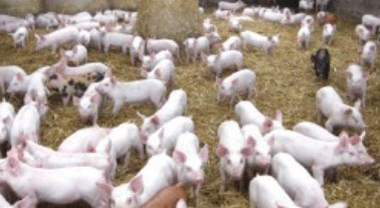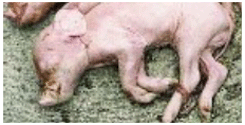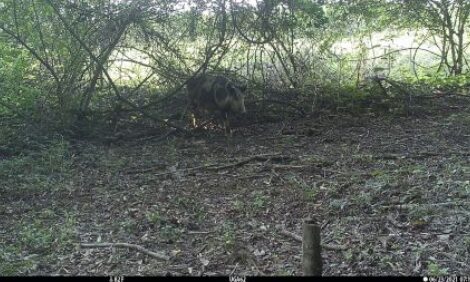



Porcine Reproductive and Respiratory Syndrome (PRRS) Virus
The symptoms, implications and control of this economically significant disease are described in no. 41 in the 'Action for Productivity' series from BPEX.In the UK, clinical signs of Porcine Reproductive and Respiratory Syndrome Virus (PRRSV) infection were first observed in South Humberside in May 1991. Since then, the virus has quickly spread within the national pig herd and more than 60 per cent of pig herds are affected (as of September 2011). The virus may cause increased return rates in sows and gilts, abortions, high pre-weaning mortality and respiratory disease in growing/finishing pigs.
Targets
- To improve external and internal biosecurity
- To reduce reproductive losses in the breeding herd
- To improve the growth and efficiency of the rearing herd
Impact on Performance
PRRSV affects pigs of all ages. Clinical signs include:
- Reproductive loss in sows:
- Return to oestrus
- Abortion
- Premature farrowing
- Mummified foetuses
- Stillbirths
- High pre-weaning mortality
- In weaners, growers and finishers - not eating, dullness, reddening of the skin, laboured breathing, rough hair coats and a failure to thrive
- An increase in mortality and severity of disease may be seen as a result of secondary infections.
The clinical disease caused by PRRSV is highly variable between farms. While some herds have fairly consistent rates of respiratory disease others may have respiratory ‘flare-ups’ and/or periodic outbreaks of reproductive disease in breeding sows.
There is increased susceptibility to other infectious diseases, particularly respiratory diseases, in pigs infected post-weaning because of the effects of PRRS virus infection on the immune system.
Economic Impact of PRRS
The cost of PRRSV to an individual unit can vary significantly. Estimated costs for a hypothetical non-vaccinated 500-sow breeder/finisher herd are:
Reproductive Problems
- Acute phase – total loss in net margin: £40,000 or £80 per sow
- Chronic phase – total loss in net margin: £53,590 or £107.18 per sow per year
(based on a survey of 12 UK veterinary surgeons in Richardson, 2011).
Respiratory Problems
Overall cost if a vaccination strategy is not used: £52,180 or £104.36 per sow per year (Richardson, 2011).
In a study in the Netherlands, the average cost of an outbreak in a commercial sow herd was similar and estimated to be around €75 (around £65) per sow.
The costs after the outbreak varied greatly, with estimated costs ranging from €3 to €160 (around £2.60 to £139) per sow, because of the differences in responses by farmers from eradication of PRRSV to just stabilisation in the herd (Nieuwenhuis et al., 2011)

Transmission
PRRSV can be introduced in to a herd via:
- replacement pigs
- vectors, such as flies, slurry, etc
- aerosol (windborne) over short distances.
The virus does not survive well outside the host, although once within a herd PRRSV can be transmitted:
- by nose to nose contact (most likely method)
- from sow to piglet during pregnancy, with a higher probability of transmission the later the sow is infected during pregnancy
- by contaminated needles
- through fighting (via saliva and blood)
- by close contact with slurry and/or infected carcases
- in semen
- by birds and insects
- on contaminated clothes.
Persistently infected animals can shed virus and infect contacts. Piglets born to sows that have been exposed in the recent past to PRRSV may be born viraemic.
Sows that are immune to PRRSV can transfer immunity to piglets through their colostrum, however, once this immunity wanes, usually at around sinx to eight weeks of age, piglets can become infected if exposed to the virus.
Risk Factors
Herds are more likely to be affected by PRRSV if they:
- are close to other pig herds (within 2 miles, 3.5km)
- have more than 250 sows
- do not isolate purchased stock or do not isolate for a sufficient period of time.
Vaccination
- Vaccination has been associated with a reduction in the numbers of weak and unhealthy pigs, reductions in fever, lung lesions and virus circulation in the blood and improvements in growth rates
- Vaccination has been shown to increase the number of viable piglets and reduce reproductive problems in sows in field studies
- Effectiveness might be influenced by the PRRSV strain(s) present on the farm and how different these are to the vaccine virus.
Elimination
Strategies for PRRS virus elimination include whole herd depopulation repopulation, test and removal, herd closure and partial depopulation.
- Elimination of PRRSV from a pig herd involves a reduction in prevalence in all areas of the herd so that overall transmission is reduced
- Closure of the breeding herd with no gilt introductions for six to eight months reduces PRRS virus circulation
- Partial depopulation of weaners, growers and finishers prevents horizontal transmission of PRRS virus to the breeding herd. Temporary off-site accommodation is required to house depopulated pigs.
- Elimination is possible, however, many herds become re-infected with virus
- If re-infection occurs it is important to determine the source, so that repeat breakdowns and the risk to other farms can be minimised.
Management Guidelines
The most effective options for reducing the probability of introducing PRRSV to a herd include:
- Close the herd and only use replacements that have been bred on-farm
- Introduce only known negative replacements
- Isolate replacement gilts off-site for at least two weeks and preferably up to eight weeks before introduction into the main herd
- Routine vaccination of breeding stock using a modified live PRRS vaccine if the farm is in an ‘at risk’ area
- Because of the risk of aerosol spread, pig farms that are close to each other should consider working together to eliminate PRRSV from their area
- Any changes should be discussed with your vet.

References
Richardson, J. (2011). The cost of endemic disease in pig production. The Pig Journal, 65:10-17.
Nieuwenhuis, N., Duinhof, T., Hogeveen, H. and Van Nes, A. (2011) Economical Analysis of PRRSv-Outbreaks in Nine Sow Herds.
Proceedings of the 3rd European Symposium of Porcine Health Management, Espoo, Finland, 94-95.
July 2013






